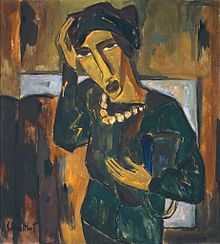Karl Schmidt-Rottluff
Karl Schmidt-Rottluff (1 December 1884 – 10 August 1976) was a German expressionist painter and printmaker, one of the four founder-members of the artist group Die Brücke.
Life and work

He was born Karl Schmidt in Rottluff, Saxony, today a district of Chemnitz, and attended the Humanistisches Gynasium in Chemnitz.[1] He began to study architecture in Dresden, but gave up after a term,[1] when he became a founder member of a group of artists known as Die Brücke ("The Bridge"), along with his fellow architecture students Ernst Ludwig Kirchner, Fritz Bleyl and Erich Heckel. The group was founded in Dresden on 7 June 1905, and its first exhibition opened in Leipzig in November of the same year.
In 1906 he added "Rottluff" to his surname. He spent the summer of that year on island of Alsen, in the company of Emil Nolde. From 1907 to 1912 he spent the summers on the coast at Dangast, near Bremen. In December 1911, like the rest of members of Die Brücke he moved from Dresden to Berlin.[1] The group was dissolved in 1913. He served in the army on the eastern front in 1915–18, before returning to Berlin, where he spent the rest of his life, except for a period during the Second World War, when he returned to Rottluff following the destruction of his studio in an air raid.[1]
The honours bestowed on Schmidt-Rottluff after World War I, as Expressionism officially recognized in Germany, were taken away from him after the rise to power of the Nazis. He was expelled from the Prussian Academy of Arts in 1933, two years after his admission.[2] In 1937, 608 of Schmidt-Rottluff's paintings were seized from museums by the Nazis and several of them shown in exhibitions of "degenerate art" ("Entartete Kunst"). By 1941 he had been expelled from the painters guild and forbidden to paint.
After the war, in 1947, Schmidt-Rottluff was appointed professor at the University of Arts in Berlin-Charlottenburg, through which he again exercised an important influence on a new generation of artists. An endowment made by him in 1964 provided the basis for the Brücke Museum in West Berlin, which opened in 1967 as a repository of works by members of the group.[2]
He was a prolific printmaker, with 300 woodcuts, 105 lithographs, 70 etchings, and 78 commercial prints described in Rosa Schapire's Catalogue raisonné.
He died in Berlin in 1976.
Collections
Schmidt Rottluff's works are included in the collections of, among others, the Museum of Modern Art, New York; the Neue Galerie, New York; the Los Angeles County Museum of Art. The Museum am Theaterplatz in Chemnitz has a large collection of work from Schmidt-Rottluff.[3]
See also
- Letter from Adolf Ziegler about the Nazi seizure of work.
- Departure from the Akademie der Künste
Notes and references
- ↑ 1.0 1.1 1.2 1.3 Carey, Frances; Griffiths, Anthony (1984). "Karl Schmidt-Rottluff". The Print in Germany 1880–1933. London: British Museum Publications. p. 123. ISBN 0-7141-1621-1.
- ↑ 2.0 2.1 Karl Schmidt-Rottluff Museum of Modern Art, New York.
- ↑ Elizabeth Zach (July 27, 2012), In Germany, an Unlikely Art Hub Honed by Enthusiasm New York Times.
External links
 Media related to Karl Schmidt-Rottluff at Wikimedia Commons
Media related to Karl Schmidt-Rottluff at Wikimedia Commons Quotations related to Karl Schmidt-Rottluff at Wikiquote
Quotations related to Karl Schmidt-Rottluff at Wikiquote
| |||||||||||
|